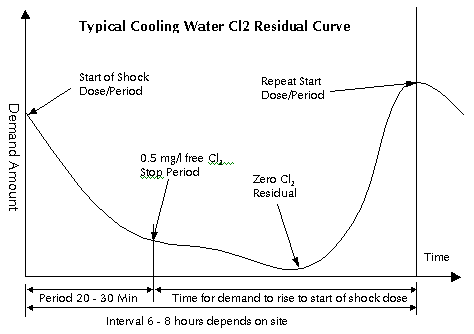|
The amount of chlorine needed to destroy the biofouling
organisms in the water and oxidize organic and inorganic
matter is called the "chlorine demand" of
the system. The chlorine feed rate depends upon the
degree of biofouling expected under the worst conditions,
the non biological chlorine demand in the water, the
holding time in the system, and the discharge limitations.
It is difficult to give an exact chlorine demand curve
because it depends on the local geographical conditions
- summer, winter, temperatures, etc. It's a matter of
judgment. The followings graph is the typical demand
residual curve in cooling tower waters.
- You decide at what level
of demand you wish to start shock dosing.
- The length of shock dosing
is dependent on time for water to go from point of
Cl2 injection till it reaches the sample
point on the return to cooling tower. (circuit time)
- Time to reach zero residual
depends on site conditions.
- More important is the
level of demand that does not cause problems before
starting shock dosing cycle.
\

What the above means is you
find the circuit time of the system, set the shock dosing
for this time (period), then you set amount of Cl2
based on 5 mg/liter shock dose as follows:
M3 of water flow
through circulating pumps multiplied by dosage (5 mg/liter)
divided by 1000 - this equals kg/hr to which you must
set the rotometer.
Kg/hr = M3/hr
x dosage rate (mg/liter) / 1000
You check period by measuring
the Cl2 residual at the sample point in the
return line, at about 0.5 mg/liter. Free chlorine (HOCl)
is when you stop the period, adjust the timer if necessary.
|